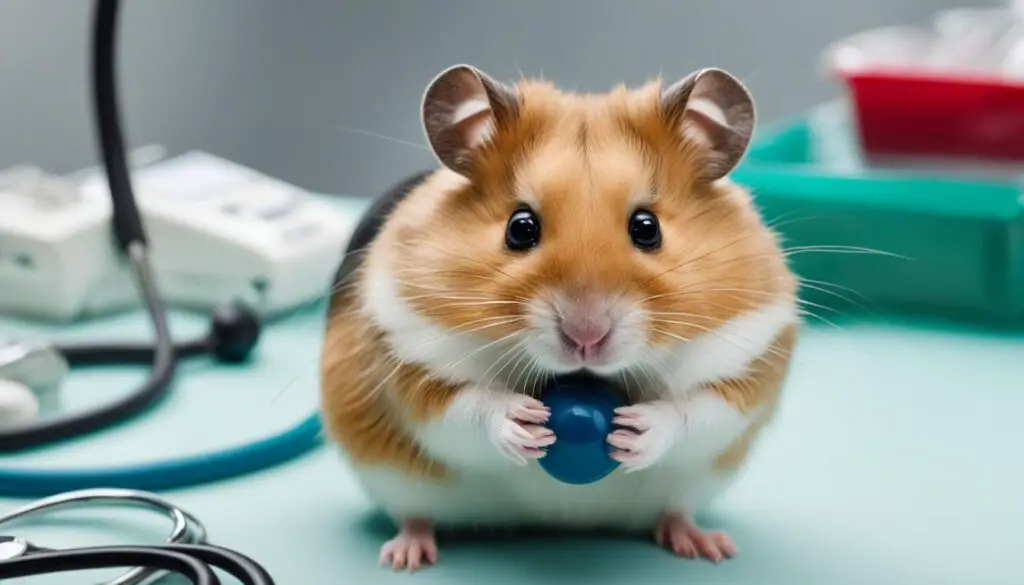As a hamster owner, I understand the unique challenges that come with managing a nocturnal pet. Hamsters are adorable and fascinating creatures, but their natural behavior can sometimes disrupt our sleep routines. That’s why it’s essential to provide the right care and create a harmonious environment for our furry friends. In this article, I will share some valuable tips and tricks on managing your hamster’s nocturnal behavior, ensuring a happy and healthy life for both you and your little companion.
Key Takeaways:
- Understand and respect your hamster’s nocturnal nature.
- Choose the right hamster housing to provide a safe and comfortable environment.
- Follow a balanced diet with commercial hamster pellets as the main component.
- Regular veterinary visits are crucial for your hamster’s health.
- Handle your hamster gently and provide a calm environment for bonding.
By implementing these tips and tricks, you can effectively manage your hamster’s nocturnal lifestyle and create a loving and supportive home for your little companion.
Choosing the Right Hamster Housing
Hamster housing plays a crucial role in providing a safe and comfortable environment for your pet. When selecting the perfect cage for your hamster, there are several factors to consider, such as cage size, bedding, and enrichment. Let’s explore these aspects in detail.
Cage Size
Hamsters need ample space to move and explore. A cage with a minimum size of 15-20 gallons is recommended, providing enough room for your furry friend to roam and exercise. Additionally, ensure the cage has at least 150 square inches of solid floor space to accommodate your hamster’s natural instinct to burrow.
Bedding
Choosing the right bedding is essential for your hamster’s comfort and overall well-being. Opt for bedding materials that are safe and absorbent. Carefresh or grass hay are excellent options as they provide soft and cozy bedding while absorbing odors effectively. Regularly clean and replace the bedding to maintain a clean and hygienic environment for your pet.
Enrichment
Enrichment items are vital for keeping your hamster mentally and physically stimulated. Provide a variety of toys, hideaways, tunnels, and climbing structures to keep your hamster active and entertained. An exercise wheel is also essential to satisfy their natural instinct to run and stay fit. Regularly rotate the enrichment items to keep things interesting and prevent boredom.
| Aspect | Recommendation |
|---|---|
| Cage Size | Minimum 15-20 gallons |
| Floor Space | At least 150 square inches |
| Bedding | Carefresh or grass hay |
| Enrichment | Toys, hideaways, exercise wheel, tunnels |
Creating a Healthy Hamster Diet
A balanced diet is crucial for your hamster’s health. Providing the right mix of nutrients will ensure they stay happy and energetic. When it comes to a hamster’s diet, there are a few key components to consider.
Commercial Food as the Main Component
I recommend commercial hamster pellets or blocks as the main component of your hamster’s diet. These specially formulated foods are designed to provide the necessary nutrients for your pet’s well-being. Look for products that contain around 16% protein to support their growth and development.
Supplementing with Seed-Based Diets
While commercial food should be the primary component, seed-based diets can be used sparingly as a supplement. Seeds are high in fat and can lead to weight gain and other health issues if overfed. Use them as occasional treats rather than a staple in your hamster’s diet.
Offering Fresh Fruits and Vegetables
Fresh fruits and vegetables are a great way to add variety and extra nutrients to your hamster’s diet. Some suitable options include greens like spinach and kale, seeds like sunflower and pumpkin seeds, carrots, and slices of apple. However, it’s important to introduce new foods gradually to prevent digestive upsets. Offer small amounts and monitor your hamster’s response.
| Fresh Fruits | Fresh Vegetables |
|---|---|
| Apples | Carrots |
| Bananas | Cucumbers |
| Strawberries | Broccoli |
Important Note on Diet Changes
When introducing new foods or making changes to your hamster’s diet, keep in mind their sensitive digestive systems. Gradual transitions are essential to avoid stomach issues. Start by introducing small portions of new foods alongside their regular diet and gradually increase the amount over the course of a few weeks.
“A balanced hamster diet should consist of commercial food as the main component, supplemented with seeds and occasional fresh fruits and vegetables. Gradual transitions and careful monitoring of your hamster’s response to new foods are essential for their digestive health.”
Meeting Hamster’s Medical Needs
Regular veterinary visits are essential for maintaining your hamster’s health. It is important to prioritize their medical care and ensure their well-being. Hamsters, like any other pets, can be susceptible to various illnesses. By staying proactive and attending veterinary visits, you can catch and treat potential health issues early and provide your hamster with the necessary care.
Thorough Examinations and Weight Checks
During veterinary visits, your hamster will undergo a comprehensive examination to assess their overall health and well-being. The vet will check for any abnormal physical signs, such as lumps, bumps, or skin issues. They will also perform a weight check to monitor your hamster’s growth and ensure they are maintaining a healthy weight.
Dental Evaluations
Just like humans, hamsters’ dental health is crucial. Dental issues can cause discomfort and affect your hamster’s ability to eat or groom properly. A dental evaluation during veterinary visits will help identify any dental problems, such as overgrowth or dental disease, and appropriate measures can be taken to manage and treat these conditions.
Discussion of Diet and Husbandry
During veterinary visits, it is essential to discuss your hamster’s diet and husbandry practices with the vet. They can provide guidance on the appropriate diet for your hamster’s specific needs and ensure that their nutritional requirements are being met. They can also address any concerns or queries you may have regarding your hamster’s care and provide expert advice on maintaining a safe and comfortable environment for your pet.
Common Illnesses in Hamsters
Hamsters can be prone to certain illnesses and health issues. Some of the common illnesses that hamsters may experience include:
- Cheek pouch impaction
- Respiratory issues
- Diarrhea
- Dental disease
- Skin wounds
If you notice any abnormal behavior, changes in appetite, or other signs of illness in your hamster, it is crucial to seek veterinary care promptly.
Annual Check-ups for Early Detection
Annual check-ups are highly recommended for hamsters, even if they appear healthy. These routine visits allow the vet to monitor your hamster’s health and detect any underlying issues that may not be immediately visible. Early detection and treatment of illnesses can significantly improve your hamster’s prognosis and overall well-being.
Remember, the well-being of your hamster is your responsibility as a pet owner. By prioritizing their medical care and attending regular veterinary visits, you ensure that your furry friend receives the best possible care and enjoys a healthy and happy life.
Proper Hamster Handling
Hamsters can be easily startled or frightened, so it’s important to handle them with care. Here are some tips for proper hamster handling:
- Approach your hamster gently: When handling your hamster, approach them slowly and calmly. Sudden movements can startle them and may cause them to bite or try to escape.
- Use a two-handed technique: To ensure a secure grip on your hamster, use a two-handed technique. Place one hand over their back, just behind the front legs, and support their hindquarters with your other hand.
- Avoid sudden movements: Make sure to avoid any sudden movements while handling your hamster. Sudden jerks or quick actions can cause your hamster to panic and can lead to injury or stress.
- Provide a calm and quiet environment: Handling your hamster in a calm and quiet environment can help keep them calm and relaxed. Limit loud noises and sudden disturbances during the handling process.
“It’s crucial to approach hamsters with care and gentleness to establish trust and ensure their well-being.” – Dr. Emily Johnson
Daily handling is crucial for socializing and taming your hamster. It helps them become more comfortable with human interaction and reduces fear or aggressive behaviors. Be patient and consistent with handling to build a bond with your furry friend.
Maintaining a Clean Hamster Cage
Cleaning your hamster’s cage is essential for maintaining a healthy and hygienic environment. Regular cage cleaning not only promotes your hamster’s well-being but also ensures a pleasant living space for both you and your furry friend.
To keep your hamster cage clean, follow these simple steps:
- Remove your hamster from the cage and place them in a safe and secure temporary holding area.
- Dispose of any soiled litter or bedding. Use a mild soap solution or a specialized cage cleaning solution to thoroughly clean the cage. Pay special attention to corners, crevices, and any areas that may be harboring bacteria.
- Rinse the cage thoroughly to remove any soap residue.
- Allow the cage to air dry or use a clean towel to dry it completely.
- Once the cage is dry, add fresh litter and bedding, ensuring a comfortable and cozy space for your hamster.
- Inspect the water bottle for any leaks or blockages. Clean and refill it with fresh water daily to ensure your hamster stays hydrated.
- Regularly monitor your hamster’s coat, nails, and rear end for cleanliness. If necessary, gently groom your hamster using a small, soft brush or a damp cloth.
By maintaining a clean hamster cage, you are not only promoting good hygiene but also preventing the build-up of odors and potential health risks for your hamster. Remember to observe your hamster’s behavior and adjust the cleaning routine as necessary, especially if your hamster tends to have a specific area where they eliminate waste.
“Regular cage cleaning is crucial for maintaining your hamster’s health and preventing the spread of diseases. A clean and hygienic cage will also reduce the chances of unpleasant odors, providing a pleasant living environment for both you and your furry friend.” – [Your Name]
Keeping your hamster’s cage clean is an important aspect of responsible hamster ownership. It not only ensures your hamster’s well-being but also allows you to create a bond with your pet in a clean and hygienic environment.
| Benefits of Regular Cage Cleaning | Tips for Effective Cage Cleaning |
|---|---|
| – Maintains good hygiene for your hamster – Prevents the spread of diseases – Reduces unpleasant odors | – Use a mild soap solution or specialized cage cleaning solution – Thoroughly clean all areas of the cage – Rinse and dry the cage completely – Inspect and clean the water bottle daily – Monitor your hamster’s cleanliness |
Promoting Natural Behavior and Sleep Routine
Hamsters are naturally nocturnal animals, and respecting their sleep schedule is essential for their overall well-being. To ensure they have a healthy sleep routine and exhibit natural behaviors, there are several key factors to consider:
Providing Enrichment
Enrichment is essential to keep hamsters mentally stimulated and physically active. Providing a variety of toys, tunnels, and climbing structures in their cage will encourage exercise and play. Additionally, a running wheel is a must-have accessory for your hamster to engage in their natural instinct to run and explore.
“Enrichment is crucial for hamsters to lead a fulfilling and active life.”
Offering a Sand Bath
Hamsters love to groom themselves in sand, which helps keep their fur clean and healthy. Place a shallow dish with chinchilla sand in your hamster’s cage so they can indulge in their natural grooming behavior. Ensure that the sand is dust-free and suitable for hamsters.
“A sand bath provides a hygienic and enjoyable experience for your hamster.”
Creating a Calm and Dark Sleep Environment
Hamsters require adequate darkness to sleep comfortably during the day. Place your hamster’s cage in a quiet area away from direct sunlight or sources of excessive light. Keeping the cage covered with a dark, breathable fabric can provide the necessary darkness for your hamster’s sleep. It’s vital to maintain a consistent sleep routine for your hamster to help regulate their internal clock.
“Providing a calm and dark sleep environment supports your hamster’s natural sleep cycle.”
| Benefits of Promoting Natural Behavior and Sleep Routine |
|---|
| 1. Mental stimulation and physical exercise |
| 2. Improved grooming and hygiene |
| 3. Better sleep quality and overall well-being |
| 4. Reduction of stress and anxiety |
By prioritizing the promotion of natural behavior and a healthy sleep routine, you can provide your hamster with an enriching and comfortable environment that supports their physical and mental needs.
Conclusion
By implementing these essential hamster care tips, managing your pet’s nocturnal behavior becomes easier, leading to a harmonious pet-owner relationship and promoting better sleep routines for your furry friend. Providing suitable housing, a balanced diet, proper medical care, gentle handling, a clean cage, and opportunities for natural behavior are crucial aspects of hamster care.
Choosing the right hamster housing, such as a cage with adequate space and suitable bedding, ensures your pet’s comfort and security. A healthy hamster diet consisting of commercial food and occasional fresh fruits and vegetables promotes optimal health and well-being. Regular veterinary visits allow for preventive care and early detection of any potential illnesses.
Proper handling techniques, such as a gentle approach and the two-handed technique, contribute to your hamster’s trust and socialization. Maintaining a clean cage with regular cleaning and providing fresh water daily promotes hygiene. Enrichment activities and adequate darkness during sleep time support your hamster’s natural behavior and sleep routine.
By following these guidelines, you can create a nurturing environment for your hamster, foster a strong bond, and ensure the overall happiness and well-being of your pet. Remember, caring for your hamster is a rewarding responsibility that requires patience, love, and attention. Enjoy the journey of being a hamster owner!
FAQ
How big should my hamster’s cage be?
Your hamster’s cage should have a minimum size of 15-20 gallons and at least 150 square inches of solid floor space.
What type of bedding should I use in my hamster’s cage?
Suitable bedding materials for hamsters include Carefresh or grass hay.
What should I include in my hamster’s cage for enrichment?
Enrichment items such as toys, hideaways, and exercise wheels are essential for keeping your hamster active and engaged.
What should I feed my hamster?
Commercial hamster pellets or blocks containing around 16% protein are recommended as the main component of their diet. Seed-based diets should be used sparingly as a supplement.
Can I give my hamster fresh fruits and vegetables?
Yes, fresh fruits and vegetables like greens, seeds, carrots, and apples can be offered as occasional treats. Remember to introduce new foods gradually to prevent digestive upsets.
How often should I take my hamster to the veterinarian?
Regular veterinary visits are essential for maintaining your hamster’s health. Annual check-ups can help catch and treat any health issues early.
How should I handle my hamster?
Approach your hamster gently with both hands using a two-handed technique to ensure a secure grip. Avoid sudden movements and provide a calm and quiet environment.
How often should I clean my hamster’s cage?
Regular cage cleaning is necessary to maintain a healthy and hygienic environment for your hamster. Use a mild soap solution or cage cleaning solution to clean the cage and remove any soiled litter/bedding.
Should I provide a sand bath for my hamster?
Yes, offering a sand bath allows your hamster to engage in natural grooming behavior.
Should I provide darkness for my hamster during its sleep time?
Yes, hamsters are naturally nocturnal animals and require adequate darkness during their sleep time. Ensure that your hamster’s cage is located in a quiet area.







No Comments